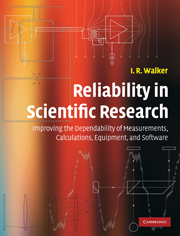 Reliability in Scientific Research
Reliability in Scientific Research Book contents
- Frontmatter
- Contents
- Preface
- List of abbreviations
- 1 Basic principles of reliability, human error, and other general issues
- 2 Mathematical calculations
- 3 Basic issues concerning hardware systems
- 4 Obtaining items from commercial sources
- 5 General points regarding the design and construction of apparatus
- 6 Vacuum-system leaks and related problems
- 7 Vacuum pumps and gauges, and other vacuum-system concerns
- 8 Mechanical devices and systems
- 9 Cryogenic systems
- 10 Visible and near-visible optics
- 11 Electronic systems
- 12 Interconnecting, wiring, and cabling for electronics
- 13 Computer hardware and software, and stored information
- 14 Experimental method
- Index
- References
14 - Experimental method
Published online by Cambridge University Press: 05 June 2012
- Frontmatter
- Contents
- Preface
- List of abbreviations
- 1 Basic principles of reliability, human error, and other general issues
- 2 Mathematical calculations
- 3 Basic issues concerning hardware systems
- 4 Obtaining items from commercial sources
- 5 General points regarding the design and construction of apparatus
- 6 Vacuum-system leaks and related problems
- 7 Vacuum pumps and gauges, and other vacuum-system concerns
- 8 Mechanical devices and systems
- 9 Cryogenic systems
- 10 Visible and near-visible optics
- 11 Electronic systems
- 12 Interconnecting, wiring, and cabling for electronics
- 13 Computer hardware and software, and stored information
- 14 Experimental method
- Index
- References
Summary
Introduction
The main purpose of this chapter is to examine certain trouble-prone aspects of experimental work that are often not considered, but if neglected can have major consequences. These include errors caused by the subconscious biases of experimenters, which are often the origin of mistaken conclusions in scientific research. In those areas of research that involve the study of material samples, very serious errors are commonly made because the true compositions of the samples are different from what is believed. This issue is also discussed below. The chapter also looks at the problems that can arise in reproducing the experimental measurements and techniques of other researchers. Several of the points are illustrated by historical examples. Some potential pitfalls in the analysis of data are discussed here, and also in Section 2.2.7.
Knowing apparatus and software
It is important to understand (at least at the conceptual level, if not in all the details) the inner workings of one's apparatus and software, and the theories they are based on. The effort needed to acquire this understanding is often avoided by experimenters. This tendency is encouraged by the ubiquitous presence in laboratories of highly automated commercial instruments, which are easy to treat as black boxes.
Having a conceptual understanding of apparatus and software can help to reduce human errors that might otherwise occur during their use (see page 17). Also, without such an understanding, the limitations and eccentricities of these things may not be readily perceived.
- Type
- Chapter
- Information
- Reliability in Scientific ResearchImproving the Dependability of Measurements, Calculations, Equipment, and Software, pp. 536 - 563Publisher: Cambridge University PressPrint publication year: 2011


